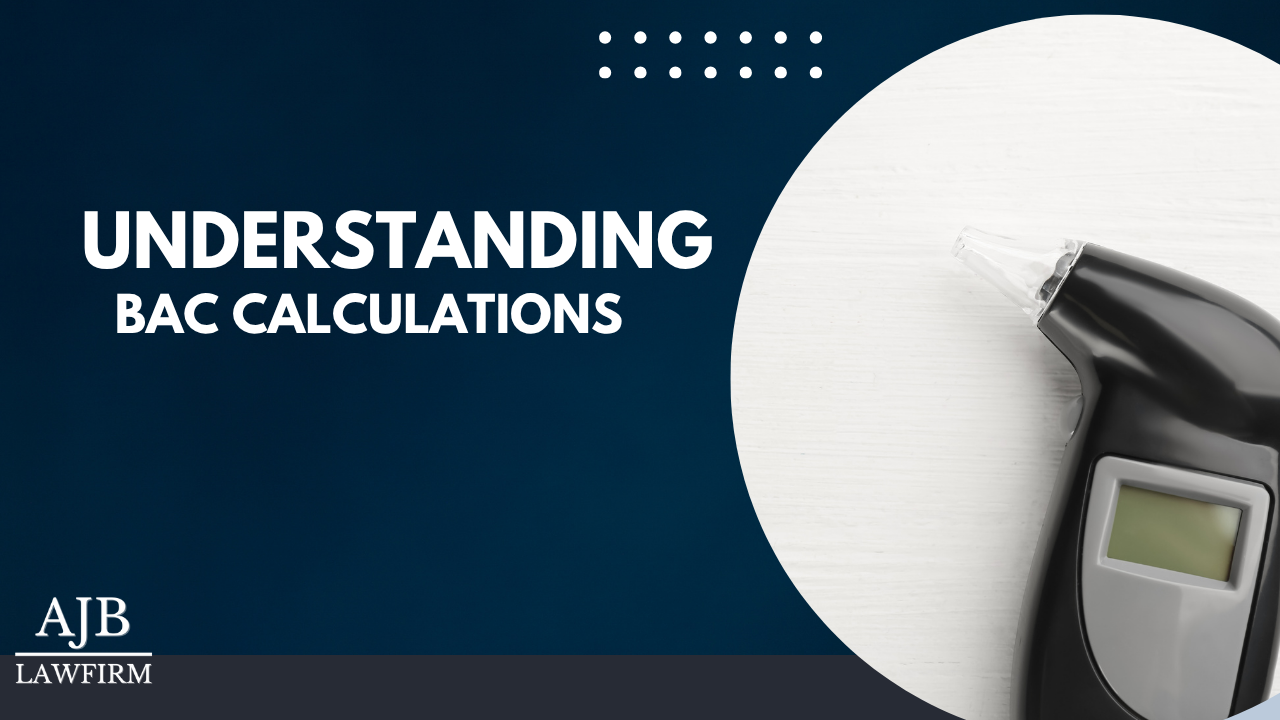Think You Know Your BAC? Here’s Why DUI Cases Aren’t That Simple
You’re out with friends, having a good time. You’ve had a couple of drinks, but you feel okay. You decide to drive home, thinking you’re under the legal limit. Then you see those flashing lights. The officer stops you, administers some tests, and draws your blood. Later, the results show a BAC of 0.118% — over the legal limit of 0.08%.
How did this happen? How can you be over the limit when you thought you were fine?
Blood Alcohol Concentration (BAC) is more complicated than most people think. In this post, we’ll break down how BAC works, why these calculations are often misleading, and why you need an experienced DUI attorney if you’re facing charges.
What is BAC and How is it Measured?
Blood Alcohol Concentration (BAC) is the measure of how much alcohol is in your bloodstream. It’s usually expressed as a percentage. In Arizona, as in most states, the legal limit for driving is 0.08%.
Here’s a quick explanation:
A 0.08% BAC means there are 0.08 grams of ethanol (alcohol) per 100 mL of blood.
Police can measure your BAC through:
Breath Tests (Breathalyzers)
Blood Tests (Most accurate, used for legal proceedings)
Urine Tests (Less common)
If your BAC is 0.08% or higher, you can be charged with a DUI, even if you don’t feel drunk.
How BAC Decreases Over Time
Alcohol doesn’t stay in your system forever. The human body processes and eliminates alcohol over time. On average, the body metabolizes alcohol at a rate of 0.015% per hour.
For example:
If your BAC is 0.118% at 3:30 a.m., your body will typically reduce it by 0.015% per hour.
By 12:30 p.m. (9 hours later), your BAC would theoretically drop to 0.00% if you didn’t consume any more alcohol.
But is it really that simple? Not exactly.
The Limitations of BAC Calculations
While the 0.015% per hour elimination rate is a useful average, it doesn’t apply to everyone equally. There are several factors that can influence how your body processes alcohol.
1. Individual Metabolic Rates Vary
Not everyone metabolizes alcohol at the same speed. Your genetics, age, and overall health can affect how quickly your body processes alcohol. For example:
Someone with a fast metabolism may eliminate alcohol quicker.
Someone with liver issues may process alcohol slower.
2. Alcohol Absorption is Complex
BAC doesn’t just depend on how quickly your body eliminates alcohol. It also depends on how quickly you absorb it. Factors affecting absorption include:
Food Intake: Drinking on an empty stomach leads to faster absorption.
Type of Alcohol: Carbonated drinks (like champagne) can speed up absorption.
Drinking Pattern: Binge drinking causes BAC to spike quickly.
If you drank shortly before the blood draw, your BAC might still be rising, not falling.
3. Body Size and Composition
Height and weight matter, but so does body composition:
Muscle vs. Fat: Alcohol is water-soluble, so people with more muscle (which holds more water) tend to have a lower BAC than those with more body fat.
Even if two people weigh the same, their BAC can differ based on their body fat percentage.
4. Gender Differences
Men and women process alcohol differently. Women generally have:
Less water in their bodies, leading to higher BAC levels compared to men of the same size.
Different enzyme levels that affect alcohol breakdown.
5. Medical Conditions and Medications
Conditions like diabetes or liver disease can affect alcohol metabolism. Certain medications can also interact with alcohol, changing how quickly it’s processed.
6. Measurement Errors
BAC testing isn’t foolproof:
Breathalyzers can give false readings if not properly calibrated.
Blood tests can be mishandled, contaminated, or delayed, affecting results.
Why BAC Matters in DUI Cases
When you’re charged with a DUI, the prosecution often relies heavily on your BAC. But as you can see, BAC isn’t always straightforward.
Here’s why this matters for your case:
1. Your BAC Might Not Reflect Your Condition
Imagine you stopped drinking at 1:00 a.m., and your blood was drawn at 3:30 a.m. Your BAC might still be high because your body was still absorbing alcohol. You might not have felt impaired, but the BAC says otherwise.
2. Potential for Errors and Misinterpretations
Factors like improper testing procedures, delays in drawing blood, or even contamination can lead to inaccurate BAC results. A good DUI attorney can challenge these results.
How an Experienced DUI Attorney Can Help
Facing a DUI charge can be overwhelming. But you don’t have to navigate it alone. An experienced DUI attorney can:
Challenge the BAC Evidence:
Investigate if the testing equipment was properly calibrated.
Determine if the blood draw was delayed or mishandled.
Use Expert Witnesses:
Hire forensic toxicologists to analyze your BAC results and explain the limitations.
Explore Defenses:
Rising BAC Defense: Argue that your BAC was lower while driving.
Absorption Rate: Show how food, medications, or medical conditions affected your BAC.
Negotiate with Prosecutors:
Sometimes, charges can be reduced to a lesser offense like reckless driving.
Protect Your Future:
A DUI conviction can impact your job, license, and reputation. Skilled legal representation can help minimize these consequences.
Conclusion: Don’t Let a Number Define Your Case
Blood Alcohol Concentration (BAC) might seem like a black-and-white measure, but it’s far from it. Your BAC reading depends on many factors, and it doesn’t always tell the full story.
If you’re facing a DUI charge, don’t assume the case is hopeless because of a high BAC. There are defenses available, and you have rights. An experienced DUI attorney can challenge the evidence and fight for the best possible outcome.
Need Help with a DUI Case?
Tucson DUI attorney Amanda Bynum understands the complexities of BAC and DUI law. With years of experience and a commitment to your defense, she’s ready to help you navigate this challenging time.
